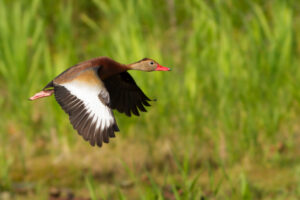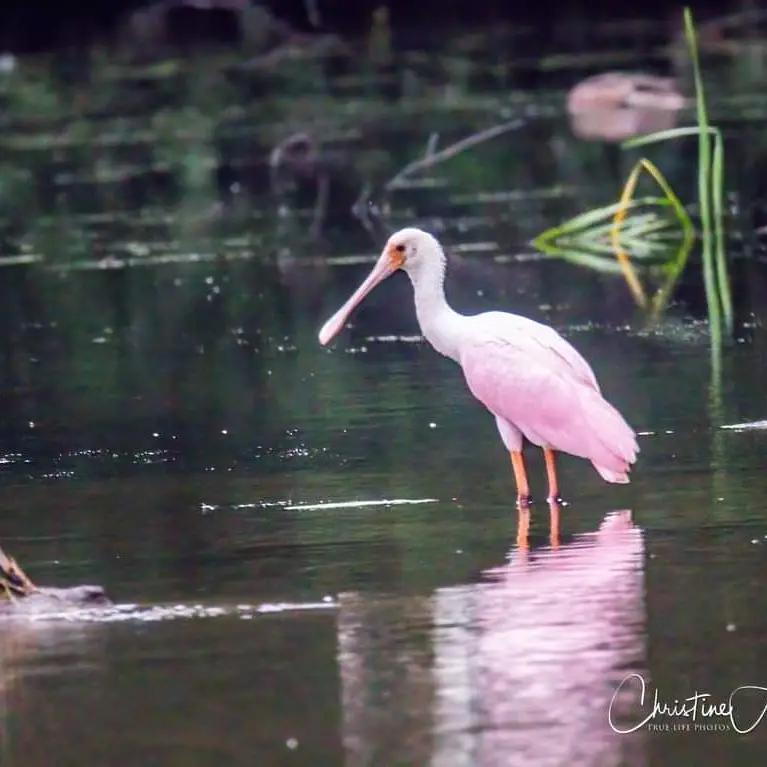I spent this month chasing target species and rarities. My target species consisted of the birds still missing from my Michigan checklist. Luckily, the Fantasy Birding website has a target species function to check for recent sightings of birds still missing from my list. I can use that function to decide where to spend the next day or so. I typically schedule two to four days at a time and check back in to make sure everything is still looking good. Unfortunately, some of my target species aren’t currently in Michigan. I’m hoping to pick those up during fall migration.
I got a real treat this month with the state record of the Roseate Spoonbill. Birders from near and far traveled to Saline, Mich., to see the elusive bird. Since the Roseate Spoonbill has never been seen in Michigan before now, this was an extremely rare treat. The sighting gathered media attention and that of birders of all ages around the state, including some from surrounding states.
Bird sightings this rare usually show up for one of two reasons. They may be a captive bird that has gotten loose or been released. Alternatively, they may have somehow been pushed off track and are somewhat lost. The spoonbill falls into the latter category.
Rarities like this can pose some ethical conundrums. When really rare birds, including state records, are reported, many birders are inspired to make a trek to see the bird. This can lead to increased stress on the bird, issues with private landowners, and safety issues with large crowds on streets or areas they aren’t generally in. One of the great things about the spoonbill sighting is that the local community embraced the rarity and set up a system for dealing with the influx of visitors.
Although I didn’t travel to the area to see the bird in person, it was inspiring to chase the bird virtually through my fantasy birding experience. I know several people who actively pursued the bird, including several members of our Michigan Young Birders Network. Their experiences ranged from seeing the bird on the first try to searching for hours with no luck. Maybe one day in the future, I’ll decide to be part of the chase and travel around the state, viewing rarities in person.
As we move into August, I’ll still plan to chase target species while also paying attention to the beginning of fall migration. I’m excited to see how fall migration picks up and how it will impact my fantasy birding experience.
Featured photo: Roseate Spoonbill by Christine Andrews
Species Highlight:
Black-bellied Whistling-Duck

I added Black-bellied Whistling-Duck to my list on July 13. Interestingly enough, this is the same day I used my field guide to identify this species from a photo during our first day of the 2021 Michigan Young Birders Camp. Black-bellied Whistling-Ducks are considered a casual species in Michigan. This means that they have been recorded — observed — more than three times, but not more than 30 times in the last 10 years, and they were recorded in fewer than nine of the last 10 years.
Photo: Black-bellied Whistling-Duck by Kyle Fritz | APA
Biggest Day
This month, my biggest day was July 5 at Pointe Mouillee State Game Area. Pointe Mouillee State Game Area covers 7,483 acres of land used for hunting and recreation. It also includes protected wildlife and wetland areas at the mouth of the Huron River at Lake Erie. I saw 94 species and added one new species to my big year. I was lucky enough to add the Blue Grosbeak.
You Can Help My Virtual Big Year!
I’m always up for suggestions on places to go on certain days, especially if people are going out birding. I don’t get to add any species if no one is reporting to eBird in the location I pick on that given day. You can email me your birding plans at [email protected].
Hotspot Highlight
This month I’d like to highlight Tiscornia Park in St. Joseph, Mich. Expect lots of sand if you decide to visit, due to the dune habitat that covers this hotspot. A total of 273 species have been seen at Tiscornia Park. I visited Tiscornia Park several times this month, looking to add some target species to my big year list. Luckily I was able to add the Lesser Black-backed Gull during one visit.

Lindsay Cain is Michigan Audubon’s education coordinator. If you are interested in learning more about our events, workshops, presentations, or event sponsorship opportunities, please contact Lindsay at 517.580.7364 or [email protected].
You can follow Lindsay’s virtual big year journey through her monthly blog posts or start your Fantasy Birding adventure and look for her on the scoreboards. You can find her under the username “lcain” with a Turkey Vulture as her avatar.

